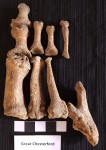 The skeleton of an adult male unearthed on the outskirts of Great Chesterford, Essex, is one of the earliest leprosy victims in Britain and a A new study has found that he may even have been the person who introduced the disease to Britain. The skeletal remains were unearthed between October 1953 and April 1954 in an Anglo-Saxon cemetery exposed in 1952 by a commercial gravel digging operation. The subsequent rescue excavations discovered 161 inhumation graves, 33 cremation graves, 2 horse and 2 dog burials. This man was in Burial GC96 which included grave goods: the remnants of a spear (the head and a conical ferrule), a buckle loop, a knife and a bronze shoelace tag.
The skeleton of an adult male unearthed on the outskirts of Great Chesterford, Essex, is one of the earliest leprosy victims in Britain and a A new study has found that he may even have been the person who introduced the disease to Britain. The skeletal remains were unearthed between October 1953 and April 1954 in an Anglo-Saxon cemetery exposed in 1952 by a commercial gravel digging operation. The subsequent rescue excavations discovered 161 inhumation graves, 33 cremation graves, 2 horse and 2 dog burials. This man was in Burial GC96 which included grave goods: the remnants of a spear (the head and a conical ferrule), a buckle loop, a knife and a bronze shoelace tag.
While his grave goods were decayed and most of his facial bones, ribs, some vertebrae and hands were missing, the bones that remained, including all the major long bones, were in good to excellent condition. The features of leprosy — narrowing of the toe bones, joint damage — were recognized on the skeletal remains in the 1950s, but other diseases can have similar effects. The well-preserved the bones allowed an international team of researchers led by the University of Leiden to apply the latest scientific analyses to confirm the diagnosis and reveal much more about the man’s life. Read the full study on PLOS ONE here.
 DNA extraction was so successful that researchers were able not just to find Mycobacterium tuberculosis complex DNA, but to identify the specific strain of leprosy. It’s from lineage 3I, a strain that has been identified before in human remains found in Scandinavia and Britain but those date to the 7th century at the earliest. This is an ancestral strain from around the 5th and 6th centuries A.D. Lipid biomarker analysis (study of the fatty molecules from the leprosy bacteria) confirmed the ancient DNA results and found on class of biomarkers distinct from the later instances of 3I found in medieval burials. Strontium isotope analysis of the teeth found that he was not local to Great Chesterford. Oxygen isotope analysis narrowed down his likely origin to Denmark, although eastern France and central Germany could not be ruled out.
DNA extraction was so successful that researchers were able not just to find Mycobacterium tuberculosis complex DNA, but to identify the specific strain of leprosy. It’s from lineage 3I, a strain that has been identified before in human remains found in Scandinavia and Britain but those date to the 7th century at the earliest. This is an ancestral strain from around the 5th and 6th centuries A.D. Lipid biomarker analysis (study of the fatty molecules from the leprosy bacteria) confirmed the ancient DNA results and found on class of biomarkers distinct from the later instances of 3I found in medieval burials. Strontium isotope analysis of the teeth found that he was not local to Great Chesterford. Oxygen isotope analysis narrowed down his likely origin to Denmark, although eastern France and central Germany could not be ruled out.
The strain type has little bearing on the pathogenesis or severity of disease, as this is dictated by the immune response to M. leprae, but rather it may be helpful in understanding the origin of disease in the Anglo-Saxon period. Other type 3I cases have been reported from medieval Britain (Winchester and Ipswich), Denmark and Sweden. A Scandinavian origin for this lineage is therefore one possibility, given the proximity of the Anglo-Saxon tribal homelands in Northern Germany with Denmark.
Radiocarbon testing found the skeleton dates to 415–545 A.D.
Project leader Dr Sarah Inskip of Leiden University concludes: “The radiocarbon date confirms this is one of the earliest cases in the UK to have been successfully studied with modern biomolecular methods. This is exciting both for archaeologists and for microbiologists. It helps us understand the spread of disease in the past, and also the evolution of different strains of disease, which might help us fight them in the future. We plan to carry out similar studies on skeletons from different locations to build up a more complete picture of the origins and early spread of this disease.”
Indeed, if the poor chap was unearthed in an ‘Anglo-Saxon cemetery’, it is probably only fair to assume that he was either a ‘Saxon’ or ‘Angle’, i.e. originating from either northern Germany / Denmark or central Germany 😀
I’m sure you know that the term Anglo-Saxon is most often used to describe people born and raised in England who were descended from the Germanic tribes that arrived during the migration period. The cemetery may have other people born in Denmark/Germany, or it may not. Either way they’re still Anglo-Saxons.